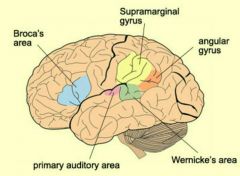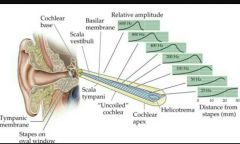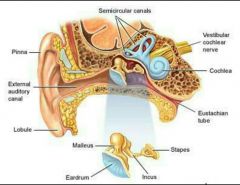![]()
![]()
![]()
Use LEFT and RIGHT arrow keys to navigate between flashcards;
Use UP and DOWN arrow keys to flip the card;
H to show hint;
A reads text to speech;
56 Cards in this Set
- Front
- Back
- 3rd side (hint)
|
adequate stimulus
|
the energy form for which the receptor is specialized. For hearing the it is the vibration in a conducting medium.
|
|
|
|
agraphia
|
The inability to write.
|
|
|
|
alexia
|
The inability to read
|
|
|
|
amplitude
|
Also called intensity. The physical energy in a sound (loudness)
|
|
|
|
angular gyrus |

Area that connect the visual projection area with the auditory and visual association areas in the temporal and parietal lobes - disruption of pathway causes alexia and agraphia |
|
|
|
aphasia
|
A language impairment caused by damage to the brain
|
|
|
|
auditory object
|
A sound that we recognize as having an identity that is distinct from other sounds.
|
|
|
|
basilar membrane |
Where the sound-analyzing structure organ of Corti is located. - acts as the auditory Fourier analyzer - responds simultaneously along its length to the sound's component frequencies |

|
|
|
Binaural
|
The use of both ears
|
|
|
|
Broca's aphasia
|
A language impairment caused by damage to Broca's area (posterior portion of the left frontal lobe) and surrounding cortical and subcortical areas. nonfluent, anomia, difficulty with articulation, agrammatical. vocalization is not lost but the ability to translate information into speech patterns is compromised. Comprehension is impaired when the meaning depends on grammatical words. aka expressive aphasia
|
|
|
|
cochlea |

Where the auditory stimulus is converted into neural impulses, which contain a million moving parts. |
|
|
|
cochlear canal
|
Where the auditory receptors are located
|
|
|
|
cocktail party effect
|
The ability to sort out meaningful auditory messages from a complex background of sounds
|
|
|
|
coincidence detectors
|
Neurons that fire most when they receive input from both ears at the same time
|
|
|
|
complex sound
|
Sound in which each is a mixture of several frequencies.
|
|
|
|
difference in intensity
|
When a sound source is to one side or the other, the head blocks some of the sound energy. As a result, the near ear receives a slightly more intense sound
|
|
|
|
difference in time of arrival
|
Refers when a sound that is directly to a person's left or right takes about 0.5 millisecond to travel the additional distance to the second ear. see coincidence detectors. brain circuit is located in the nucleus laminaris.
|
|
|
|
dyslexia
|
An impairment of reading
|
|
|
|
frequency
|
Refers to the number of cycles or waves of alternating compression and decompression of the vibrating medium that occur in a second (pitch)
|
|
|
|
frequency analysis
|
explains how people experience pitch: See frequency theories and place theories
|
|
|
|
frequency theories
|
Assumes that the auditory mechanism transmits the actual frequency of a sound to the auditory cortex for analysis there. See: frequency, telephone theory, volley theory
|
|
|
|
frequency-place theory
|
Frequency following by individual neurons accounts for frequencies up to about 200 Hz and all remaining frequencies are represented by the place of greatest activity.
|
|
|
|
frequency-volley-place theory (Wever)
|
1. individual neurons follow the frequency of sounds up to about 500 Hz by firing at the same rate as the sound's frequency,
2. from 500 to 5000Hz frequency is tracked by volleying 3. higher than 5000Hz place analysis not used see frequency-place theory |
|
|
|
inner hair cells
|
Cells that receive 90% to 95% of the auditory neurons, and they provide the majority of the information about auditory stimulation
|
|
|
|
Intensity
|
The physical energy in a sound (Amplitude and loudness)
|
|
|
|
language
|
speech and the generation and understanding of written, spoken, and gestural communication
|
|
|
|
language acquisition device
|
Part of the brain hypothesized to be dedicated to learning and controlling language.
|
|
|
|
loudness
|
The experience of sound energy (perception of amplitude)
|
|
|
|
organ of Corti
|
The sound-analyzing structure that rests on the basilar membrane. Consists of four rows of specialized cells called hair cells, their supporting cells, and the tectorial membrane above the hair cells.
|
https://o.quizlet.com/almvgJCbEomp-W859ofHxg_m.jpg
|
|
|
ossicles
|
Second part of the middle ear. Tiny bones (hammer, anvil, stirup) that operate in lever fashion to transfer vibration from the tympanic membrane to the cochlea. Provide additional amplification by concentrating energy onto the base of the stirrup.
|
https://o.quizlet.com/Q61gnP1ZHoXtm-BT3y.bpA_m.jpg
|
|
|
outer hair cells
|
Increase the cochlea's sensitivity both by amplifying its output and by sharpening the frequency tuning at the location of peak vibration
|
|
|
|
perception
|
The interpretation of sensory information.
|
|
|
|
phase difference
|
Refers to a different phase of the wave at each ear when a sound at a low frequency arrives from one side of the body
|
|
|
|
phonological hypothesis
|
hypothesis where individuals with dyslexia have an impairment in processing, storing, and/or retrieving phonemes.
|
|
|
|
pinna
|
The flap that graces the side of your head. Also called the outer ear.
|
|
|
|
pitch
|
The experience of the frequency of a sound.
|
|
|
|
place theories
|
States that identifying the frequency of a sound depends on the location of maximal vibration on the basilar membrane and which neurons are firing most. Place analysis is the reason we can hear through bone conduction. See frequency-volley-place theory and frequency-place theory, resonance and frequency sensitivity
|
|
|
|
planum temporale
|
Where Wernicke's area is located.
|
|
|
|
prosody
|
The use of intonation, emphasis, and rhythm to convey meaning in speech.
|
|
|
|
pure tone
|
Sound in which each has only one frequency.
|
|
|
|
receptor
|
A cell, often a specialized neuron that is suited by its structure and function to respond to a particular form of energy, such as sound.
|
|
|
|
resonance
|
the vibration of an object in sympathy with another vibrating object (high frequency to high-frequency and low-frequency to low-frequency) frequency selectivity is due to differences in elasticity with the membrane near the stirrup 100 times stiffer than at the apical end.
|
|
|
|
sensation
|
The acquisition of sensory information
|
|
|
|
tectorial membrane
|
Part of the organ of Corti located above the hair cells.
|
|
|
|
telephone theory
|
Belief that individual neurons in the auditory nerve fire at the same frequency as the rate of vibration of the sound source. (Rutherford) - cannot fire at high rates - see volley theory
|
|
|
|
tonotopic map
|
Each successive area responds to successively higher frequencies because the auditory cortex is organized topographically
|
|
|
|
topographical organization
|
Neurons from adjacent receptor locations project to adjacent cells in the cortex.
|
|
|
|
tympanic membrane
|
Also called the ear drum. The first part of the middle ear. Thin membrane stretched across the end of the auditory canal; its vibration transmits the sound energy to the ossicles.
|
|
|
|
Wernicke's aphasia
|
Damage to posterior porting of the left temporal lobe. Condition in which the person has difficulty understanding and producing spoken and written language. aka receptive aphasia. fluent but meaningless "word salad". has prosody.
|
|
|
|
volley theory
|
States that groups of neurons follow the frequency of a sound at higher frequencies, where as a single neuron cannot (Wever)
|
|
|
|
binaural cues for sound localization
|
difference in intensity, difference in time of arrival at the two ears, phase difference
|
|
|
|
Fourier analysis
|
analysis of a complex waveform into its sine wave components
|
|
|
|
dorsal stream - the where
|
1. flows from the auditory cortex through the parietal area
2. brain combines information from other senses to locate the sound 3. information proceeds to frontal lobes to locate sound with eyes and pan movements |
|
|
|
ventral stream (what)
|
1. flows from the auditory cortex through the temporal lobes
2. brain combines information from other senses to identify the sound 3. information proceeds to frontal lobes |
|
|
|
frequency sensitivity
|
occurs on basilar membrane
|
|
|
|
Wernicke-Gschwind Model
|
used to show how Broca's area and Wernicke's area interact to produce language
1.Verbal input arrives in the auditory cortex - to Wernicke's for interpretation 2. Written input arrives from the visual cortex to Wernicke's for interpretation 3. for verbal response - Wernicke's sends to Broca's for articulation and the facial area of the motor cortex to produce the speech |
|

